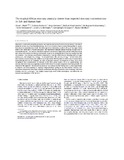The tropical African mercury anomaly: lower than expected mercury concentrations in fish and human hair
Date
2011-02-20Author
Black, F.J.
Bokhutlo, T.
Somoxa, A.
Maethamako, M.
Modisaemang, O.
Kemosedile, T.
Cobb-Adams, C.
Mosepele, K.
Publisher
ElsevierType
Published ArticleMetadata
Show full item recordAbstract
Mercury is a neurotoxin and global pollutant, and wetlands and newly flooded areas are known to be sites of enhanced production of monomethylmercury, the form of mercury that is readily biomagnified in aquatic food chains to potentially toxic levels. The Okavango Delta in Botswana, Southern Africa, is the largest inland delta in the world and a wetland ecosystem that experiences dramatic annual flooding of large tracts of seasonal floodplains. The Delta was, therefore, expected to be home to high mercury levels in fish and to be an area where local subsistence fishing communities would be at substantial risk of mercury toxicity from fish consumption. Total mercury concentrations measured in 27 species of fish from the Okavango Delta averaged (mean±s.d., wet weight) 19±19 ng g−1 in non-piscivorous fish, and 59±53 ng g−1 in piscivorous fish. These mercury concentrations are similar to those reported for fish from lakes in other areas of tropical Africa, demonstrating that not all wetlands are sites of elevated mercury concentrations in biota. Even more intriguing is that concentrations of mercury in fish from across tropical Africa are systematically and substantially lower than those typically reported for fish from freshwater ecosystems elsewhere globally. The reasons for this apparent “African mercury anomaly” are unclear, but this finding poses a unique opportunity
to improve our understanding of mercury's biogeochemical cycling in the environment. Mercury concentrations measured in human hair collected in subsistence fishing communities in the Okavango Delta were similarly low (0.21±0.22 μg g−1 dry weight) despite high levels of fish consumption, and reflect the low mercury concentrations in the fish here.
Collections
- Research articles (ORI) [270]

